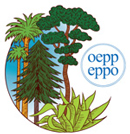
73rd meeting of the Panel on Phytosanitary Measures
EPPO Headquarters, 2025-04-01/03
The Panel met in Paris in the EPPO headquarters on 2025-04-01/03 and was attended by 12 participants all from a different EPPO country and from EFSA. The main task of this Panel is to evaluate risks presented by specific pests and design phytosanitary measures to avoid their introduction and spread (see link for composition and terms of reference of the Panel).
.jpg)
Group photo of the Panel on Phytosanitary Measures (2025-04-01/03)
EPPO Lists of pests recommended for regulation
Recommendations for regulation by EPPO are made either based on EPPO pest risk analyses (PRAs) prepared by Expert Working Groups (EWG), or PRA reports based on national/EU PRAs. The Panel reviewed the following documents:
- Xylotrechus pyrrhoderus (Coleoptera: Cerambycidae) – draft EPPO PRA.
- Resseliella citrifrugis (Diptera: Cecidomyiidae) – PRA report based on DROPSA report, an EFSA pest categorization, an EFSA Quantitative Risk Assessment and Quickscan by the NPPO of the Netherlands.
The Panel recommended to the Working Party on Phytosanitary Regulations the addition of these two pests to the EPPO A1 List.
- Pochazia shantungensis and Pochazia chinensis (Hemiptera: Ricaniidae) – PRA report based on an EFSA pest categorization. The Panel received presentations on a very recent DEFRA PRA and about economic impact in Türkiye, and concluded that these two species would not be recommended for regulation mainly because of lack of evidence of economic impact in the EPPO region and of the several outbreaks and interceptions there, suggesting that it may already be more widely distributed than already reported. However, P. shantungensis would be maintained on the EPPO Alert List while further surveillance is carried out.
Recent information received on the situation for Ilarvirus APLPV (American plum line pattern virus), ‘Candidatus Phytoplasma phoenicium’, Meloidogyne ethiopica, Phyllosticta citricarpa, Aleurocanthus woglumi (Hemiptera: Aleyrodidae) and Scirtothrips aurantii (Thysanoptera: Thripidae) was shared with the Panel. All these pests were maintained on the EPPO A1 List. The Panel was also updated about the situation of Xylella fastidiosa subsp. fastidiosa in Puglia (Italy). The Panel continued a discussion on the delisting of pests from EPPO A1/A2 Lists and recommended the use of fit for purpose PRAs to provide technical justification. Criteria for objections from EPPO countries should be clarified and the process presented to the Working Party on Phytosanitary Regulations. Three pests were selected as pilots to test the process.
Alert List
The Panel reviewed the EPPO Alert List (the purpose of this List is to warn countries about possible new risks, and in certain cases to propose candidates for PRA, and, if relevant, recommend them for regulation). Considering that an alert had been given, the Panel recommended deletion of Elasmopalpus lignosellus (Lepidoptera: Pyralidae – Lesser cornstalk borer), Euplatypus parallelus (Coleoptera: Curculionidae: Platypodinae) and Lambdina fiscellaria (Lepidoptera: Geometridae – hemlock looper). The other reasons for deletion from the list include a very low likelihood of entry on Asparagus for E. lignosellus, lack of climatic suitability for establishment of Euplatypus parallelus and low trade volume of host commodities of Lambdina fiscellaria (an update on inspection performed in 2024 on mosses and lichens was also provided during the Panel).

Photo of Panel members during the meeting (2025-04-01)
Pest Risk Analysis
The selection of priorities for the organization of EWGs for PRA for the year to come was performed. The four highest priorities for PRA identified by the Panel were Litylenchus crenatae mccannii – Beech leaf disease, Clavibacter nebraskensis which causes Goss’s wilt and leaf blight of maize, Austropuccinia psidii and Anoplophora horsfieldii (Coleoptera: Cerambycidae).
The Panel considered that preparing a PRA report on Euzophera semifuneralis (Lepidoptera: Pyralidae) the American plum borer was the highest priority for 2025, the report would be based on the EFSA pest categorisation and would provide analysis on the likelihood for establishment in the region as this was identified as an area of concern by the Panel.
The Panel then considered three pests that were evaluated to have a similar priority for a PRA report in 2025. This included a PRA report on Xylotrechus chinensis (Coleoptera: Cerambycidae) based on the EFSA pest categorisation and a pest categorization from France. The Panel also recommended a PRA report for Phlyctinus callosus (Coleoptera: Curculionidae) considering its potential trade implications and based on the previous DROPSA reports, DEFRA PRA, EFSA pest categorisation and EFSA Quantitative PRA. Finally, the Panel also recommended a PRA report for Monema flavescens (Lepidoptera: Limacodidae) based on the EFSA pest categorisation, as well as an old PRA and a recent Quickscan from the Netherlands NPPO.
The priorities for an EPPO PRA or a PRA report will be discussed with the Working Party on Phytosanitary Regulations.
The Panel highlighted the benefit of further developing the pathway tool in EPPO Global Database for inspections and to contribute to commodity topics e.g. at IPPC level. The Panel was also updated by EFSA on new mandate on rapid PRAs.
Standards
A revision of PM 4/17 Certification scheme for olive trees and rootstocks was presented to the Panel but put on hold pending finalizing the RNQP Project part 2 which involves the re-assessment of the RNQP status for some pests in this Standard.
Projects
The Panel was given a presentation on ongoing developments of the BeXyl Project and results of thermal treatment for plants infected with Xylella fastidiosa. The presentation covered efficacy of different treatment protocols in vitro and in planta and viability of propagating planting materials. A working group may be set up towards the end of 2025 to discuss the drafting or revision of EPPO Standards in the series PM10 on Phytosanitary Treatments following the results of the work.
The next Panel meeting is planned for 2024-10 in Dublin.
